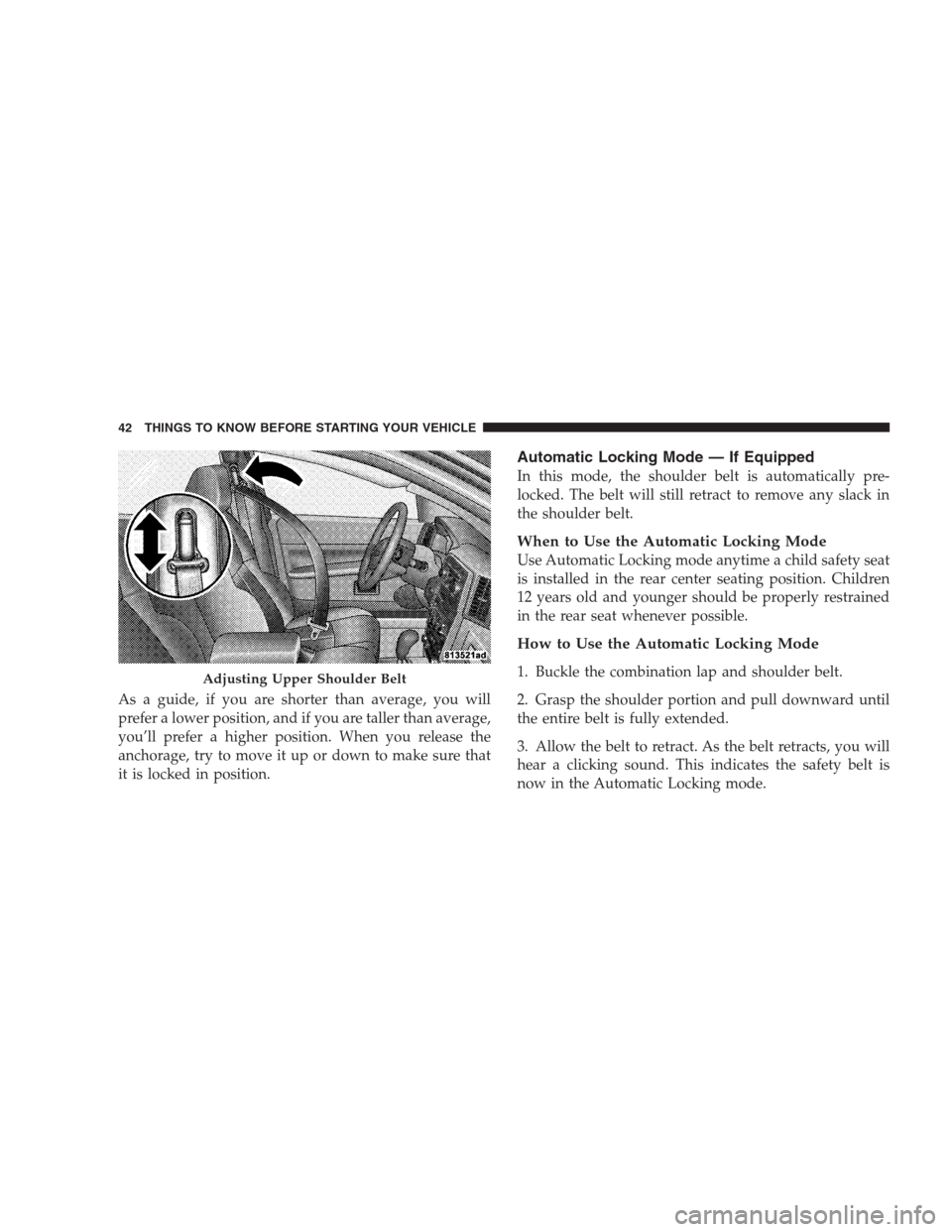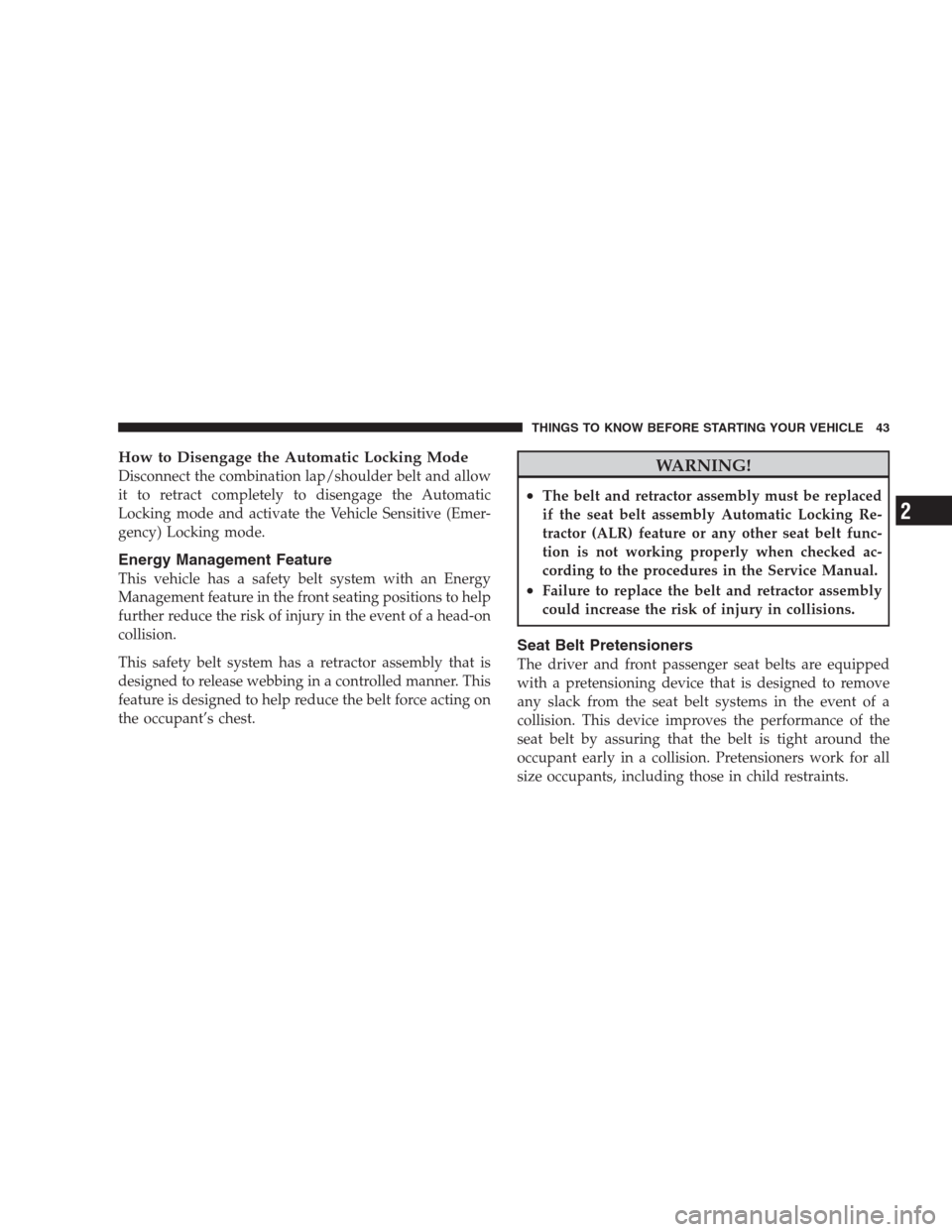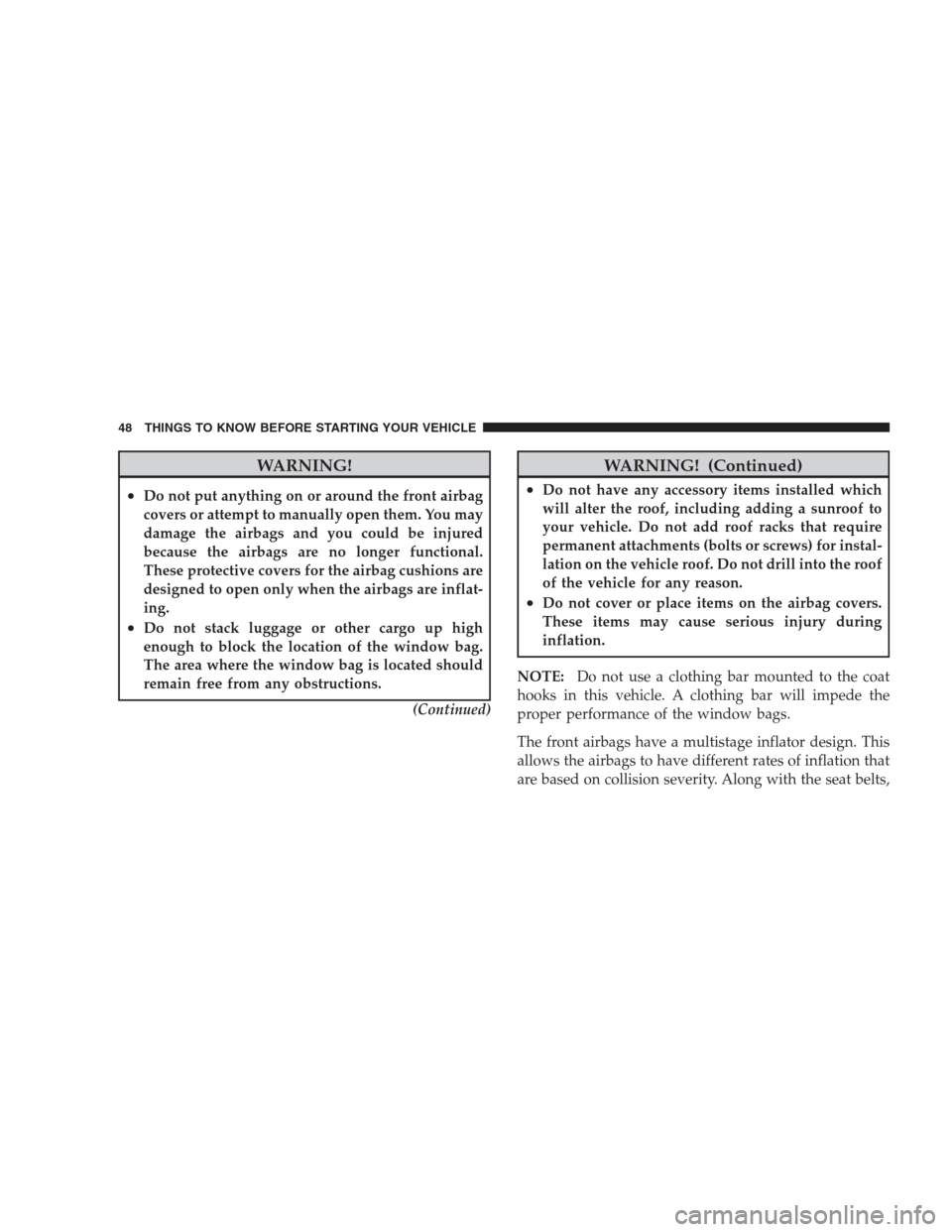Page 33 of 521
WINDOWS
Power Windows
The power window controls are located on the driver’s
door trim panel. There is a single switch on the front
passenger door/rear doors which operates the frontpassenger/rear passenger door windows. The window
controls will operate only when the ignition switch is in
the ON or ACCESSORY position.
The power window switches remain active for up to
10 minutes after the ignition switch has been turned OFF.
Opening a vehicle front door will cancel this feature.
Child Protection Door Lock
Power Window Switches
THINGS TO KNOW BEFORE STARTING YOUR VEHICLE 31
2
Page 35 of 521
Resetting the Auto Up Feature
Should the Auto Up feature stop working, the window
probably needs to be reset. To reset Auto Up:
Pull the window switch up and close the window com-
pletely, then pull and hold the switch for one second.
Window Lockout Switch
The window lockout switch on the driver’s door allows
you to disable the window controls on the other doors. To
disable the window controls on the other doors, press the
window lockout button. To enable the window controls,
press the window lockout button again.
Wind Buffeting
Wind buffeting can be described as the perception of
pressure on the ears or a helicopter-type sound in the
ears. Your vehicle may exhibit wind buffeting with the
windows down, or the sunroof (if equipped) in certain
Window Lockout Switch
THINGS TO KNOW BEFORE STARTING YOUR VEHICLE 33
2
Page 36 of 521
open or partially open positions. This is a normal occur-
rence and can be minimized. If the buffeting occurs with
the sunroof open, adjust the sunroof opening to minimize
the buffeting.
LIFTGATE
To open the liftgate, pull up (squeeze) on the handle and
lift. Manually unlocking the vehicle doors with the
plunger or a key in the lock cylinder will not unlock the
liftgate.
WARNING!
Driving with the liftgate open can allow poisonous
exhaust gases into your vehicle. You and your pas-
sengers could be injured by these fumes. Keep the
liftgate closed when you are operating the vehicle.
Liftgate Release
34 THINGS TO KNOW BEFORE STARTING YOUR VEHICLE
Page 37 of 521
Liftgate Flipper Glass
The liftgate flipper glass is also unlocked when the
liftgate is unlocked. To open the flipper glass, push up on
the window switch located on the liftgate.WARNING!
To avoid injury, stand back when opening. Glass may
automatically rise.
Once the liftgate flipper glass has been opened, connec-
tion to the rear window wiper is interrupted, preventing
activation of the rear wiper blade while the flipper glass
is open.
NOTE:If a malfunction to the liftgate latch should
occur, an emergency liftgate latch release can be used to
open the liftgate. The emergency liftgate latch release can
be accessed through a snap-in cover located on the
liftgate trim panel.
Liftgate Glass Release
THINGS TO KNOW BEFORE STARTING YOUR VEHICLE 35
2
Page 39 of 521

WARNING! (Continued)
•Buckle up even though you are an excellent driver,
even on short trips. Someone on the road may be a
poor driver and cause a collision which includes
you. This can happen far away from home or on
your own street.
•Research has shown that seat belts save lives, and
they can reduce the seriousness of injuries in a
collision. Some of the worst injuries happen when
people are thrown from the vehicle. Seat belts
reduce the possibility of ejection and the risk of
injury caused by striking the inside of the vehicle.
Everyone in a motor vehicle should be belted at all
times to reduce or prevent injuries.
Lap/Shoulder Belts
All seating positions in your vehicle have combination
lap/shoulder belts. The belt webbing retractor is de-
signed to lock during very sudden stops or collisions.This feature allows the shoulder part of the belt to move
freely with you under normal conditions. But in a colli-
sion, the belt will lock and reduce the risk of you striking
the inside of the vehicle or being thrown out.
WARNING!
•Wearing a seat belt incorrectly is dangerous. Seat
belts are designed to go around the large bones of
your body. These are the strongest parts of your
body and can take the forces of a collision the best.
Wearing your belt in the wrong place could make
your injuries in a collision much worse. You might
suffer internal injuries, or you could even slide out
of part of the belt. Follow these instructions to
wear your seat belt safely and to keep your pas-
sengers safe, too.
(Continued)
THINGS TO KNOW BEFORE STARTING YOUR VEHICLE 37
2
Page 44 of 521

As a guide, if you are shorter than average, you will
prefer a lower position, and if you are taller than average,
you’ll prefer a higher position. When you release the
anchorage, try to move it up or down to make sure that
it is locked in position.
Automatic Locking Mode — If Equipped
In this mode, the shoulder belt is automatically pre-
locked. The belt will still retract to remove any slack in
the shoulder belt.
When to Use the Automatic Locking Mode
Use Automatic Locking mode anytime a child safety seat
is installed in the rear center seating position. Children
12 years old and younger should be properly restrained
in the rear seat whenever possible.
How to Use the Automatic Locking Mode
1. Buckle the combination lap and shoulder belt.
2. Grasp the shoulder portion and pull downward until
the entire belt is fully extended.
3. Allow the belt to retract. As the belt retracts, you will
hear a clicking sound. This indicates the safety belt is
now in the Automatic Locking mode.Adjusting Upper Shoulder Belt
42 THINGS TO KNOW BEFORE STARTING YOUR VEHICLE
Page 45 of 521

How to Disengage the Automatic Locking Mode
Disconnect the combination lap/shoulder belt and allow
it to retract completely to disengage the Automatic
Locking mode and activate the Vehicle Sensitive (Emer-
gency) Locking mode.
Energy Management Feature
This vehicle has a safety belt system with an Energy
Management feature in the front seating positions to help
further reduce the risk of injury in the event of a head-on
collision.
This safety belt system has a retractor assembly that is
designed to release webbing in a controlled manner. This
feature is designed to help reduce the belt force acting on
the occupant’s chest.
WARNING!
•The belt and retractor assembly must be replaced
if the seat belt assembly Automatic Locking Re-
tractor (ALR) feature or any other seat belt func-
tion is not working properly when checked ac-
cording to the procedures in the Service Manual.
•Failure to replace the belt and retractor assembly
could increase the risk of injury in collisions.
Seat Belt Pretensioners
The driver and front passenger seat belts are equipped
with a pretensioning device that is designed to remove
any slack from the seat belt systems in the event of a
collision. This device improves the performance of the
seat belt by assuring that the belt is tight around the
occupant early in a collision. Pretensioners work for all
size occupants, including those in child restraints.
THINGS TO KNOW BEFORE STARTING YOUR VEHICLE 43
2
Page 50 of 521

WARNING!
•Do not put anything on or around the front airbag
covers or attempt to manually open them. You may
damage the airbags and you could be injured
because the airbags are no longer functional.
These protective covers for the airbag cushions are
designed to open only when the airbags are inflat-
ing.
•Do not stack luggage or other cargo up high
enough to block the location of the window bag.
The area where the window bag is located should
remain free from any obstructions.
(Continued)
WARNING! (Continued)
•Do not have any accessory items installed which
will alter the roof, including adding a sunroof to
your vehicle. Do not add roof racks that require
permanent attachments (bolts or screws) for instal-
lation on the vehicle roof. Do not drill into the roof
of the vehicle for any reason.
•Do not cover or place items on the airbag covers.
These items may cause serious injury during
inflation.
NOTE:Do not use a clothing bar mounted to the coat
hooks in this vehicle. A clothing bar will impede the
proper performance of the window bags.
The front airbags have a multistage inflator design. This
allows the airbags to have different rates of inflation that
are based on collision severity. Along with the seat belts,
48 THINGS TO KNOW BEFORE STARTING YOUR VEHICLE